Resurgent labor shortage as the economy recovers
Along with the economic recovery, a shortage of migrant workers (min gong huang) has become apparent in China since last summer, with companies having difficulty finding workers despite exhaustive recruiting efforts, This phenomenon first emerged around 2004, but it eased temporarily in the wake of the Lehman Brothers shock, as demand for labor weakened rapidly. Since the summer of 2009, however, demand has outpaced supply in the labor market, as indicated by the recovery of the job offers to job seekers ratio in urban areas to around the pre-crisis level ( figure 1 ).
Figure1 : Employment Conditions Improve with Economic Recovery
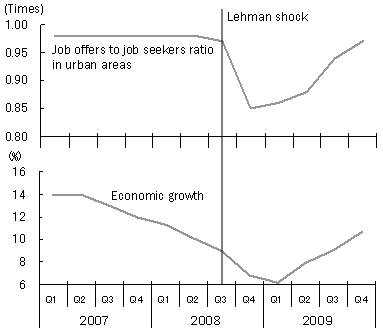
(Note) The job offers to job seekers ratio in urban areas in China is calculated by dividing the number of job offers by the number of job seekers registered with public employment service agencies in approximately 100 cities and based on the "Analysis of Supply and Demand in the Labor Market in Selected Cities" published quarterly by the China Labor Market Information Network Monitoring Center, which operates under the Ministry of Human Resources and Social Security.
(Source) National Bureau of Statistics of China, Ministry of Human Resources and Social Security, and China Federation of Logistics & Purchasing
The shortage of migrant workers is particularly serious in Eastern China (the coastal regions). For instance, Shenzhen saw the job offers to job seekers ratio rising from 0.94 in the first quarter of 2009, when the economy was at its worst, to 1.72 in the fourth quarter of 2009. The gap between supply and demand shifted from an excess supply of 103,000 people to an excess demand of 819,000 jobs (1,944,000 job offers against 1,125,000 job seekers). (Shenzhen Human Resources Services Center, " Shenzhen City, Fourth Quarter of 2009, Labor Market Supply and Demand Situation Analysis ," (in Chinese only)
In addition to the economic recovery, structural changes in the Chinese economy have contributed to the current labor shortage.. Such changes include accelerated economic growth in the central and western regions which together make up (the inland region) and the arrival of the Lewisian Turning Point, with China reaching the stage of full employment in its process of economic development.
Accelerated economic growth in the inland region
First, economic development is accelerating in the inland region, which has been outgrowing Eastern China since 2007. Particularly since the Lehman Brothers collapse, the inland region has been benefiting from government stimulus amounting to four trillion yuan, announced in November 2008. In contrast, with its high dependence on overseas markets, Eastern China has been hard hit, especially in exports. As a result, the disparity between the high growth in the West and the low growth in the East has been increasingly noticeable ( figure 2 ).
Figure2 : High Growth in the West and Low Growth in the East (2009)
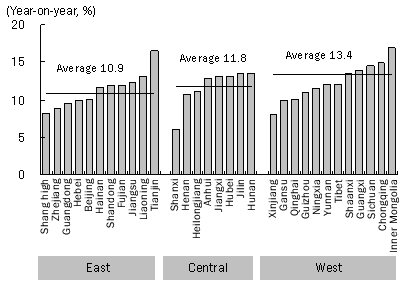
(Source) National Bureau of Statistics of China
Reflecting this trend, the flow of migrant workers has been shifting from the eastern region to the central and western regions. According to the 2009 Peasant Workers Monitoring Survey by the National Bureau of Statistics of China, the number of migrant workers working in the East declined by 8.88 million people (8.9%) from the previous year, to 90.76 million people in 2009 ( table 1 ). In the Pearl River Delta, home to many processing exporters, the number of migrant workers fell 22.5% year-on-year. In contrast, the number of migrant workers increased by 6.18 million people (33.2%), to 24.77 million people in the central region, and rose by 7.75 million people (35.8%), to 29.4 million people in the western region. In addition, the rate of increase in wages in 2009 was higher in the central region (5.9%) and the West (8.3%) than it was in the East (5.2%).. In terms of the wage level, regional differences have been diminishing, with an average monthly wage of 1,442 yuan in the East compared with 1,350 yuan in the central region and 1,378 yuan in the West. As a result, there has been less incentive for farmers in the central and western regions to migrate to the East.
Table1 : Number of Migrant Workers and Wage Level by Region (2009)
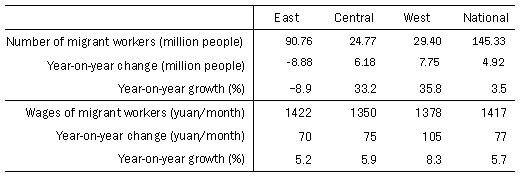
(Note) The national total of the number of migrant workers includes those in Hong Kong, Macau, Taiwan and overseas, in addition to those in Eastern, Central and Western China.
(Source) National Bureau of Statistics of China, the Department of Rural Social and Economic Survey, "2009 Peasant Workers Monitoring Survey" on March 19, 2010
Arrival of the Lewisian Turning Point
Meanwhile, China is approaching the Lewisian Turning Point, which heralds the achievement of the full employment stage of economic growth ( figure 3 ). China's one-child policy, in place since 1980, has caused significant changes to the age structure of its population. Although the percentage of the working age population initially rose as the declining birthrate advanced, it is now expected to fall with 2010 as its peak, with the aging of the population now accelerating ( figure 4 ). In addition, surplus labor in rural areas, said to be as high as 150 million people, is being eliminated.
The following observations provide strong evidence that the Lewisian Turning Point is at hand.
First, the shortage of migrant workers has become protracted and is not only limited to the eastern region, but is also spreading to the central and western regions. Moreover, the shortage is not only concentrated among engineers and skilled workers, but is now extending to unskilled workers.
Figure3 : From Labor Surplus to Labor Shortage
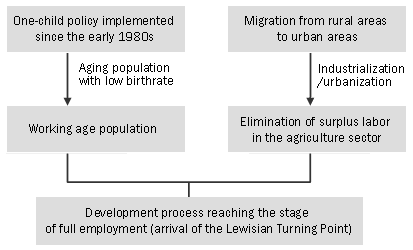
(Source) Prepared by Chi Hung KWAN
Figure4 : Growth in Total Population and Working Age Population in China
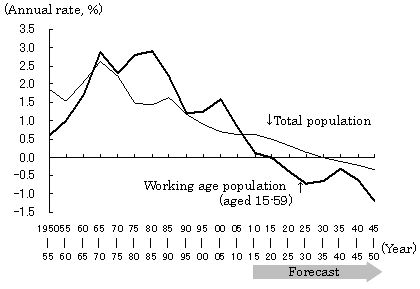
(Note) Five-year average
(Source) United Nations, World Population Prospects: The 2008 Revision
Figure5 : Higher Growth in Real Wages than GDP Growth
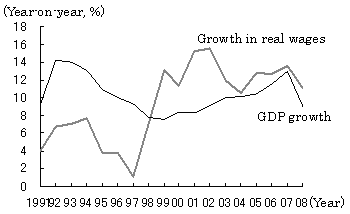
(Source) National Bureau of Statistics of China, China Statistics Summary
Second, although growth in real wages was consistently well below GDP growth until 1998, the relationship has reversed since then ( figure 5 ). Particularly in recent years, it has been reported that the rate of increase in the wages of migrant workers has been exceeding that of regular workers in urban areas (Cai Fang "Demographic Transition and Economic Growth in China" in Reports on China's Population and Labor No. 8: The Lewisian Turning Point and Policy Challenges (chapter 6) edited by Cai Fang, Social Sciences Literature Press, 2007).
Third, according to a survey conducted in 2005 on 2,749 villages in 17 provinces nationwide, although a surplus labor of approximately 100 million people remains in rural China, most are middle-aged workers who have difficulty shifting to industries other than agriculture (survey by the Team to Promote the Construction of a New Socialist Countryside, operating under the aegis of the Development Research Center of the State Council). Younger and prime-age workers who are able to work in other industries have largely moved already (Han Jun, Chuanyi Chui, Aiai Fan "Rural Surplus Labor, Findings from Village Survey," in Cai Fang, ibid (chapter 4)). In this survey, approximately three in every four villages replied that "all the young workers in the village who are capable of work have already migrated in search of jobs."
With China reaching the stage of full employment in the process of economic development, the government is likely to shift its policy priority from increasing employment to enhancing productivity growth. Once freed from the need to create massive employment opportunities, China will be ready to "graduate" from labor-intensive industries and to accelerate industrial upgrading by relocating resources to higher value-added areas. Rising wages and exchange rates will encourage companies to invest more in labor-saving machinery and to develop new business fields. As observed in the rapid development of such heavy industries as automobiles and steel, this process of industrial structuring is already taking place ( figure 6 ).
Figure6 : Image of Industrial Upgrading
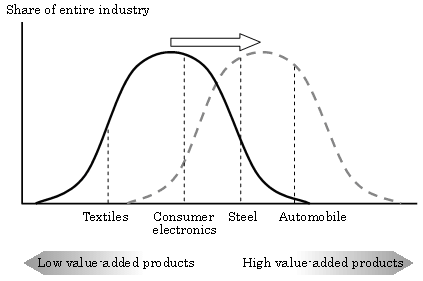
(Source) Prepared by Chi Hung KWAN


